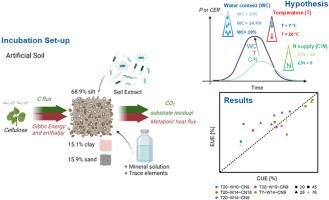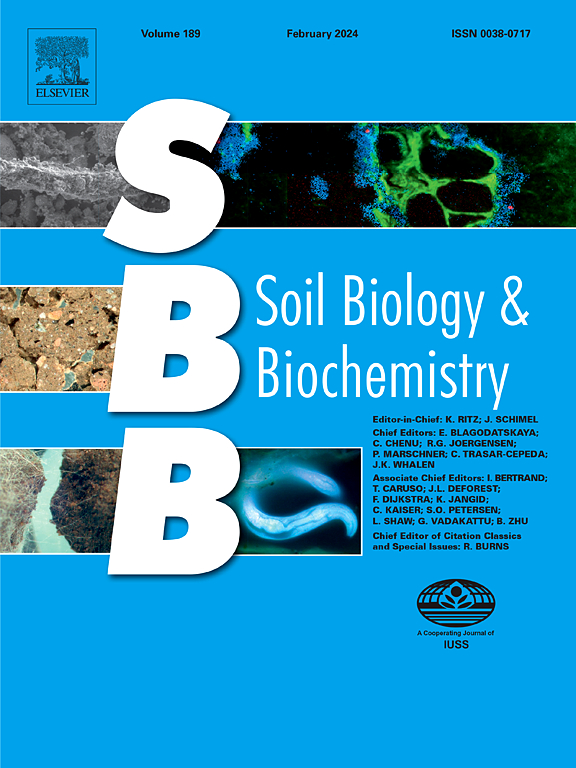在温度、含水量和碳/氮比不断变化的条件下,通过实验了解人造土壤中纤维素氧化及微生物碳和能量利用的动态变化
IF 9.8
1区 农林科学
Q1 SOIL SCIENCE
引用次数: 0
摘要
土壤是最重要的天然碳汇之一,同时还具有许多其他重要功能。纳入土壤系统的碳,例如作为生物量的碳,与来自特定基质的碳消耗量的比例,被定义为碳利用效率(CUE)。碳利用效率假定取决于环境条件。然而,土壤系统内的能量守恒(量化为能量利用效率(EUE))与 CUE 的关系尚未得到深入研究。为了研究在没有土壤有机质背景下环境条件对纤维素降解过程的影响,我们利用人工土壤分析了不同条件对 CUE 和 EUE 的影响。我们对三种含水量(10%、14.4% 和 19%)、两种 C/N 比(9 和 18)和两种温度(7 和 20)下的二氧化碳进化率、产热率和纤维素降解进行了量化。环境条件对二氧化碳演化、产热和纤维素降解率等主要参数影响很大,而衍生参数 CUE,特别是 EUE 的敏感性较低。在所研究的因素中,含水量对最终 CUE 和 EUE 的影响最小。相反,氮供应量和温度的降低往往会增加 CUE,而不会明显影响 EUE,EUE 一般高于 CUE。在降解过程中,CUE 往往从 90% 的高值降到 50% 左右的低值,而 EUE 则保持在较高的水平上。CUE 和 EUE 的变化表明微生物生长反应的化学计量发生了变化,因此在对它们进行评估时需要考虑更多的因素(如降解过程的时间间隔)。本文章由计算机程序翻译,如有差异,请以英文原文为准。


Experimental access to cellulose oxidation and the dynamics of microbial carbon and energy use in artificial soil under varying temperature, water content, and C/N ratio
Soil is one of the most important natural carbon sinks, alongside its many other critical functions. The ratio of carbon incorporated into the soil system for instance as biomass as a proportion of carbon consumption from a given substrate is defined as carbon use efficiency (CUE). CUE is assumed to depend on environmental conditions. However, the conservation of energy within the soil system, quantified as energy use efficiency (EUE), has not yet been thoroughly studied related to CUE. To study the effects of environmental conditions on cellulose degradation in the absence of soil organic matter background, we utilized artificial soil to analyse their impact on CUE and EUE. We quantified CO2 evolution rate, heat production rate, and cellulose degradation, at three water contents (10%, 14.4% and 19%), two C/N ratios (9 and 18), and two temperatures (7 and 20 ). Environmental conditions significantly influenced the primary parameters such as CO2 evolution, heat production, and cellulose degradation rate while the derived parameters CUE and in particular EUE were less sensitive. Among the studied factors, water content had the least influence on ultimate CUE and EUE. Conversely, decreases in nitrogen supply and temperature tended to increase CUE without significantly affecting EUE, which is generally higher than CUE. Over the degradation process, CUE often started from high values > 90% and then decreased to lower ones around 50%, whereas the EUE remained more constant on a higher level. The variations of CUE and EUE suggest alterations in the stoichiometry of the microbial growth reaction and thus add additional factors (e.g. time lapse of the degradation process) to be considered for their assessment.
求助全文
通过发布文献求助,成功后即可免费获取论文全文。
去求助
来源期刊

Soil Biology & Biochemistry
农林科学-土壤科学
CiteScore
16.90
自引率
9.30%
发文量
312
审稿时长
49 days
期刊介绍:
Soil Biology & Biochemistry publishes original research articles of international significance focusing on biological processes in soil and their applications to soil and environmental quality. Major topics include the ecology and biochemical processes of soil organisms, their effects on the environment, and interactions with plants. The journal also welcomes state-of-the-art reviews and discussions on contemporary research in soil biology and biochemistry.
 求助内容:
求助内容: 应助结果提醒方式:
应助结果提醒方式:


